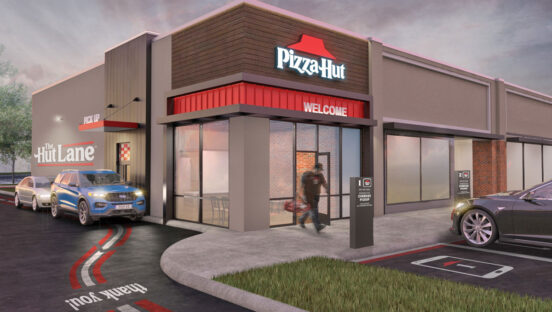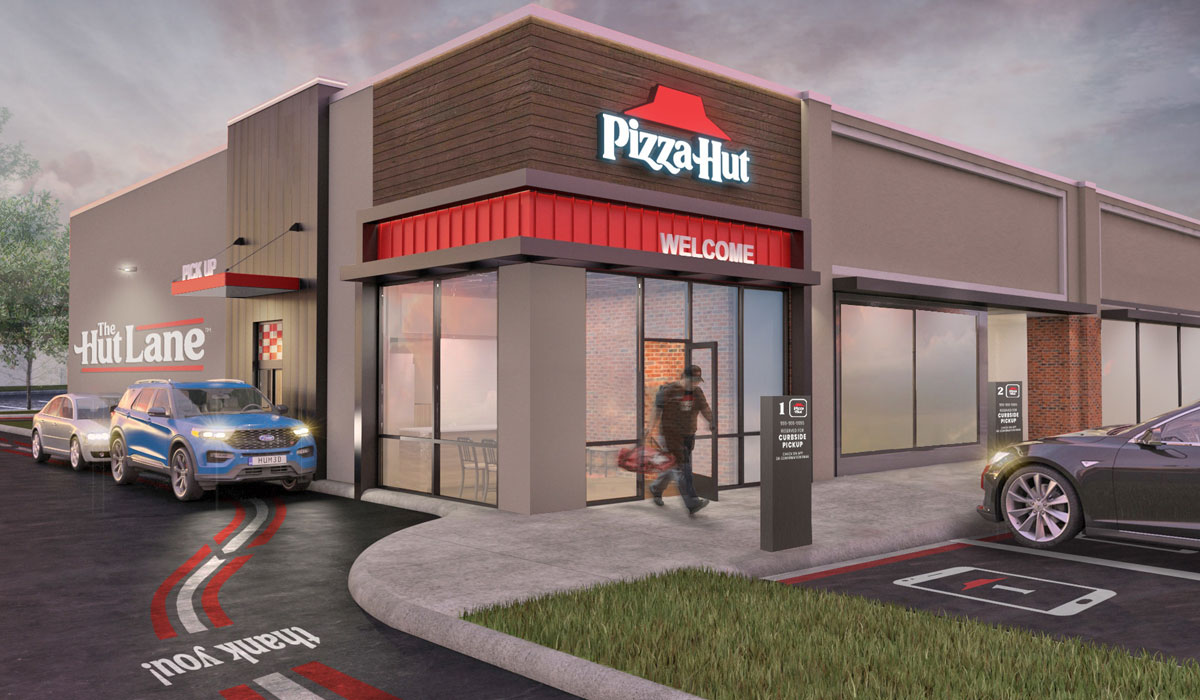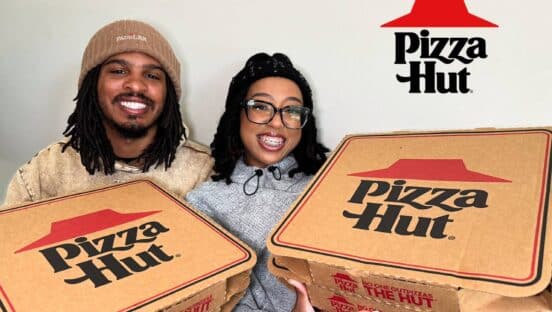Pizza Hut is joining the restaurant rush to the drive-thru. The Yum! Brands chain unveiled Tuesday “The Hut Lane,” a dedicated digital order pickup window available at more than 1,500 locations, with more to come.
Similar to Chipotle’s “Chipotlanes,” of which there are now about 200, customers access the feature through Pizza Hut’s app or online, and pull up to a dedicated window. There’s no order board. Additionally, Pizza Hut guests can place orders via phone for Hut Lane access.
“We are giving our customers a variety of options to optimize their pizza-eating experience as we build on our business momentum,” Nicolas Burquier, Pizza Hut’s chief customer and operations officer, said in a statement. “Not only do we offer industry-leading, innovative menu items that are only available at Pizza Hut, we also offer several digital-first pick-up options for our customers, and The Hut Lane is a great example of that.”
Pizza Hut claims to be the first national pizza chain to offer contactless curbside pickup, which it did nationwide in mid-April. The move came with new safety seals as well. It’s fulfilled north of 50 million contactless orders through delivery and carryout since.
As was the case with countless brands during early pandemic months, lockdown behavior led Pizza Hut to find ways for consumers to place digital orders without leaving their vehicles. The Hut Lane represents the next evolution “of this breakthrough experience, offering safety, convenience, and speed without customers ever having to park their cars,” the company said.
If The Hut Lane, which is trademarked, is not available, Pizza Hut’s app automatically offers Contactless Curbside Pickup.
READ MORE:
Pizza Hut Speeds to a More Future-Ready Restaurant Chain
14 Glimpses Into the Fast-Food Restaurant of the Future
“The Hut Lane is part of the brand’s long-term strategy to modernize through digital ordering and improved customer experiences, and many franchise owners seeking an edge on speed and convenience in their local markets will look to utilize this feature,” Pizza Hut said.
Flynn Restaurant Group, America’s larger franchise operator, is one example. The company recently assumed ownership of 937 locations as part of a deal with bankrupt NPC International. It also acquired 194 Wendy’s locations.
Flynn Restaurant Group said it plans to prioritize The Hut Lane “in many of its stores” going forward.
“As we transition into the Pizza Hut system, we are excited about The Hut Lane and the seamless customer experience it offers,” Ron Bellamy, chief improvement officer at Flynn Restaurant Group, said in a statement. “We know from our [quick-service restaurant] experience how much value a pick-up window can unlock for the business, and we plan to prioritize The Hut Lane in future builds and relocations of existing stores.”
Flynn Restaurant Group nearly doubled its unit count with the NPC acquisition, getting up to 2,355 venues across multiple categories. The company’s restaurants generate $3.5 billion in sales. Flynn Restaurant Group is also the largest Applebee’s and Arby’s franchisee, as well as the second-largest Panera Bread operator and third-largest for Taco Bell. With the deal, it became Pizza Hut’s biggest and Wendy’s fifth.
Pizza Hut said it will continue to develop plans for additional Hut Lane in-store branding elements as it looks to roll them out “in the near future.”
Of course, there’s little debate why Pizza Hut took this drive-thru-centric step. Especially with a digital tilt.
Yum!’s digital sales hit a record of $17 billion in fiscal 2020, roughly a 45 percent increase over the prior year.
Both KFC and Taco Bell saw record-breaking drive-thru performance in Q4, CEO David Gibbs said in February. KFC improved transaction times 16 seconds during the period, while Taco Bell got times below 4 minutes. The latter just revealed plans for new designs and drive-thru models this past week. This includes the first drive-thru Cantina store and a kiosk-focused store in New York City.
Yum! has been on a multi-year journey to improve Pizza Hut’s asset base, or transition it from dine-in to more carryout and delivery-friendly real estate. It closed 540 stores in Q4. For perspective, Pizza Hutt exited 2019 with 18,703 stores globally. In 2020, Pizza Hut shed 1,745 restaurants, or 9 percent of the year-ago figure, including 573 closures in Q1 and Q2 combined, and 1,172 total in Q3 and Q4. The closures were partially offset by the opening of 682 locations. Pizza Hut ended 2020 with 17,639 stores, representing a unit decline of 6 percent—its lowest global number since Q3 2018.
But this was hardly unexpected. Yum! began outlining the transition to a healthier base more than a year earlier.
NPC also decreased its footprint from about 1,200 to 950 before its sale to Flynn Restaurant Group.
And recent data suggests Pizza Hut’s overhaul is working. In the U.S., where off-premises is more prevalent, same-store sales increased 8 percent in Q4 and 3 percent for fiscal 2020. In the quarter, business outside the four walls generated 21 percent same-store sales growth when excluding closed Express units, and 18 percent same-store sales growth with Express units.
Pizza Hut also launched an omnichannel menu management system that served as one source for menu customization and pricing that can be synced across multiple digital channels.
As a company, Yum! announced March 2 it entered into a definitive agreement to acquire artificial intelligence-based consumer insights and marketing performance analytics business of Kvantum, Inc. Yum! said it would allow its brands, including fast casual The Habit Burger Grill to “enhance their ability to apply powerful consumer insights and data analytics to drive calendar and marketing spend optimization.”
Just last week, it announced another tech deal, acquiring Tictuk Technologies, an Israeli omnichannel ordering and marketing platform company. This will enable the company to “offer more ways for consumers globally to access and order its KFC, Pizza Hut, Taco Bell, and The Habit Burger Grill brands through some of the world’s most popular social media and conversational platforms,” Yum! said.
Tictuk specializes in conversational commerce, a technology solution that allows users to complete orders and interact with brands through a variety of social media and chat channels, including WhatsApp, Facebook Messenger, Telegram, SMS, QR codes, and email.









